Making a profit is every aspiring business owner’s dream — but it’s not always a reality.
Liquor store profitability requires you to stock the right products, charge the right prices, and provide the right experience. It’s a delicate balance, and checking all these boxes might sound intimidating.
But we have good news: With the right tools and techniques, healthy liquor store profit margins are possible.
In this guide, we’ll share everything you need to know about opening and running a profitable liquor store. Here’s a sneak peek at what we’ll cover:
Let’s dive in and explore how to have the most profitable liquor store in town.
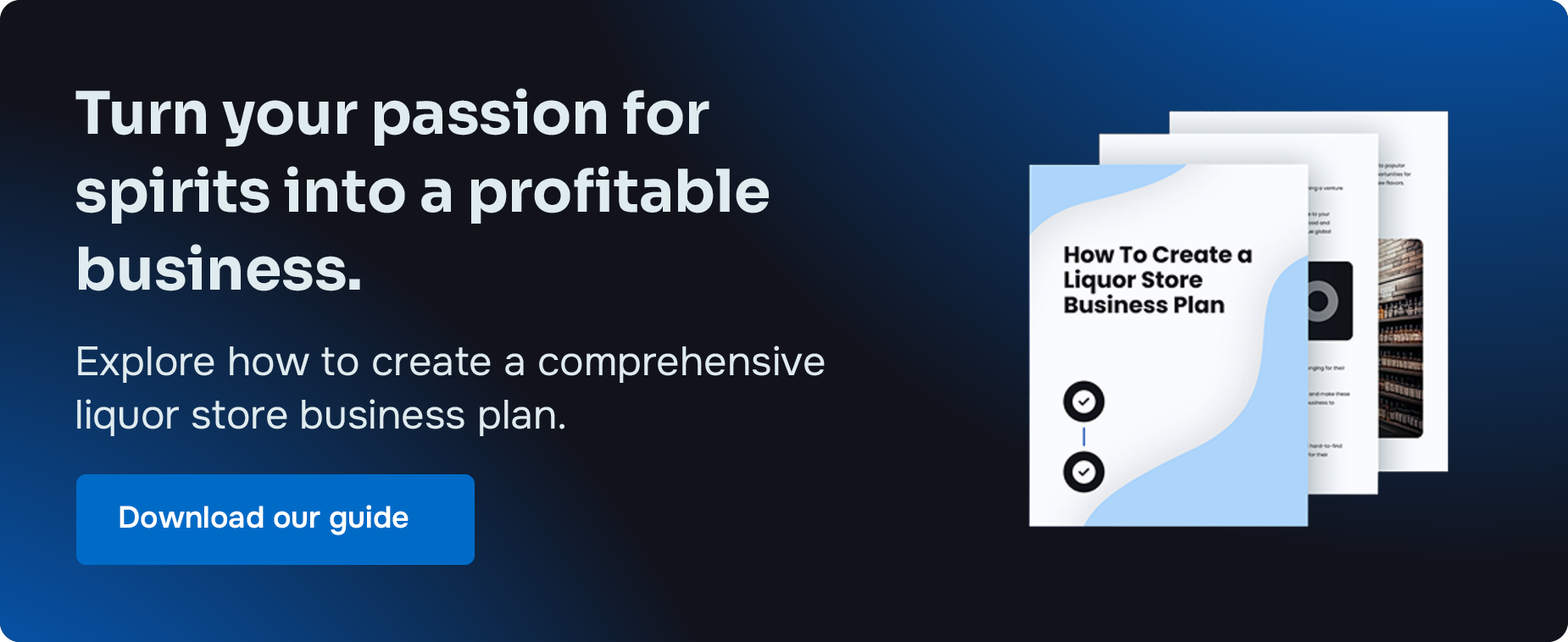
Liquor Store Profit Margin Basics
Before making a profit-boosting plan, you need to understand your liquor store’s costs. Here’s what to include when calculating your expenses.
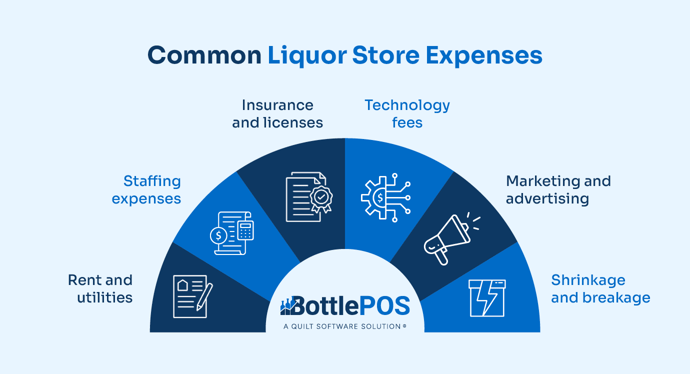
- Rent and utilities: Include your lease or commercial mortgage, utility bills, and ongoing maintenance costs.
- Staffing expenses: How much does it cost to keep your liquor store staffed? Don’t forget to include your employees’ benefits alongside wages.
- Insurance and licenses: Add the ongoing cost of small business insurance and liquor licensing fees.
- Technology fees: Include your point of sale (POS) software subscription and payment processing fees.
- Marketing and advertising: How much do you spend on marketing your store? Include paid advertising fees, as well as the cost of tastings and events.
- Shrinkage and breakage: How much money do you lose due to theft and bottle breakage? Check your POS system’s shrinkage reports if you aren’t sure.
Determine how much you spend on these line items to reveal your monthly operating expenses. From there, you can include an accurate overhead cost when calculating your profit margin by item.
For example, let’s say your monthly operating costs are $15,000, and you stock 3,000 bottles in your store. Each bottle will carry $5 in overhead before you factor in its wholesale price. If your supplier charges $10 for a standard-size bottle of vodka, your total cost for that specific product will be $15.
Once you have a handle on your cost per product (overhead + wholesale price), you can decide how much to mark it up to turn a profit.
Real-World Liquor Store Profit Margins by Product Type
Profit margins vary by product type and brand, as well as customers’ expectations based on your location and competitive landscape.
We've researched average profit margins by product to help you start on your liquor store profit margin journey. We recommend using these numbers as a rough guideline, then visiting other liquor stores in your area or using our suggested pricing tool to discover what customers are willing to pay for different spirits.
Beer
Here’s how liquor store owners usually mark up their beer selection:
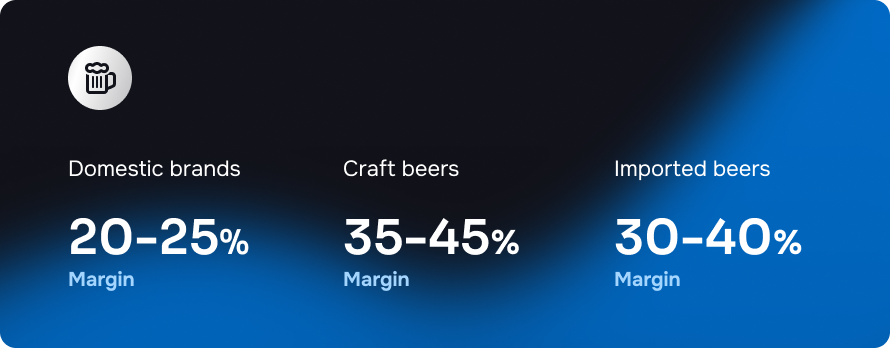
- Domestic brands: 20-25% margin
- Craft beers: 35-45% margin
- Imported beers: 30-40% margin
For example, if a case of Bud Light costs $15 wholesale, you’ll charge $19 at a 20% profit margin, or $20 at a 25% profit margin.
Wine
Wine generally has higher profit margins than most beers:
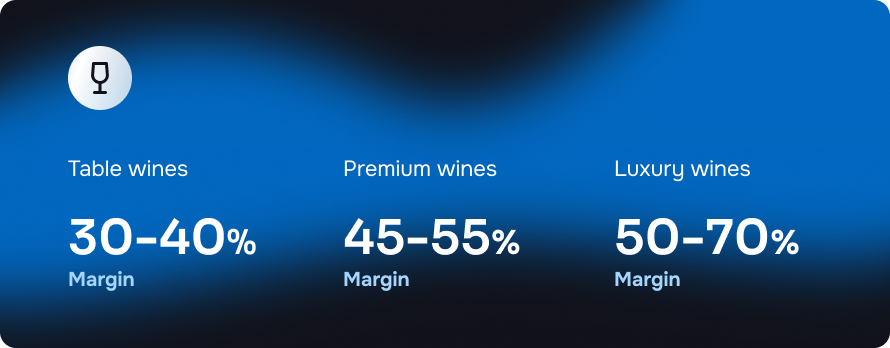
- Table wines: 30-40% margin
- Premium wines: 45-55% margin
- Luxury wines: 50-70% margin
Let’s say your wholesaler charges $12 for a bottle of premium red wine. You can charge $22 for a 45% profit margin, or $27 for a 55% margin.
Spirits
Liquor profit margins fall somewhere between beer and wine:
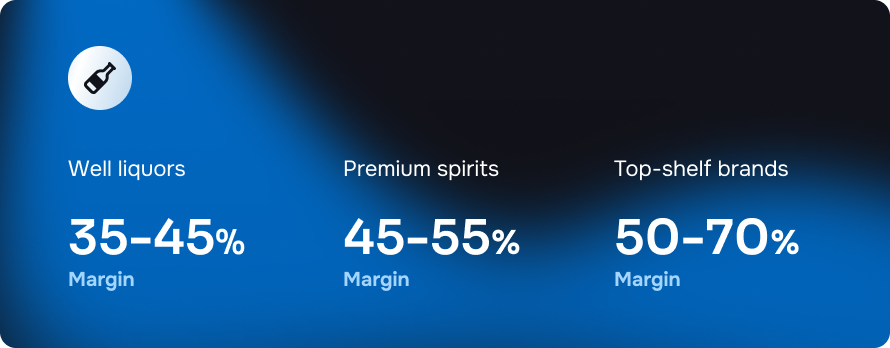
- Well liquors: 35-45% margin
- Premium spirits: 45-55% margin
- Top-shelf brands: 50-65% margin
If your supplier charges $85 for a bottle of Clase Azul tequila, you can charge $170 for a 50% profit margin, or $242 for a 65% profit margin.
Pricing your liquor store’s products requires a delicate balance. Charge a high enough profit margin to overcome your overhead and stocking costs, but don’t set prices that customers aren’t willing to pay.
Navigating State Liquor Store Regulations
Your liquor store’s pricing and profit margins aren’t always up to you. Some states have regulations that dictate what types of spirits you can stock and how much you can charge for them.
Let’s explore how you can stay compliant with your state’s unique laws while turning a profit.
Alcohol Control States
In alcohol control states, the state government takes a heavy-handed approach to regulating alcohol sales. Some states have strict rules for wholesalers and liquor stores regarding distributing spirits, while others only sell liquor through state-run package stores (ABC stores).
There are 17 alcohol control states, including:
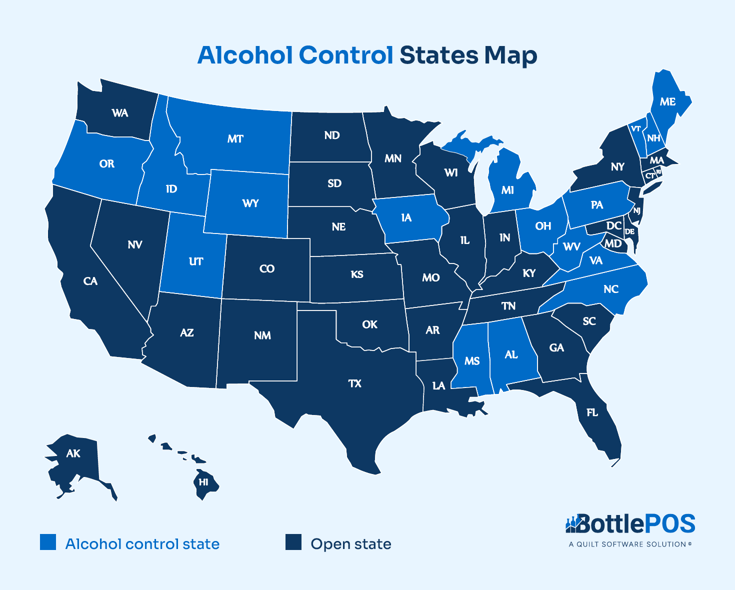
- Alabama
- Idaho
- Iowa
- Maine
- Michigan
- Mississippi
- Montana
- New Hampshire
- North Carolina
- Ohio
- Oregon
- Pennsylvania
- Utah
- Vermont
- Virginia
- West Virginia
- Wyoming
Alabama, Idaho, New Hampshire, North Carolina, Pennsylvania, Utah, and Virginia are some of the strictest alcohol control states, only allowing ABC stores to sell liquor.
If you’re planning to open a business in these states, your best chance for profitability and compliance is to choose a wine or beer specialty. For example, you might open a downtown wine shop that sells rare and luxury blends or a craft beer store that offers local brews.
Competing against state-run liquor stores also gives you a unique opportunity to stand out by offering excellent customer service. Use customer data to personalize their experiences with your liquor store, and answer their questions in a timely manner to show you care about building individualized customer relationships.
Open States
Other states have fewer restrictions on alcoholic beverage distribution and sales. While opening a liquor store in an open state means more freedom and flexibility, you’ll face tougher competition.
To become the go-to liquor store in your neighborhood, we recommend keeping a close eye on your competitors’ offerings and prices to ensure that you’re offering enough variety and value. Monitor your competitors’ shopping experience, and set your liquor store apart by training your staff, investing in a modern POS system, and launching a customer loyalty program.
Looking for specific tips for success in your state? Check out our state-specific resources:
3 Smart Ways To Increase Your Liquor Store’s Profit Margins
Want to increase profit margins without scaring customers away? Here are three strategies to boost your liquor store’s profitability without setting sky-high prices.
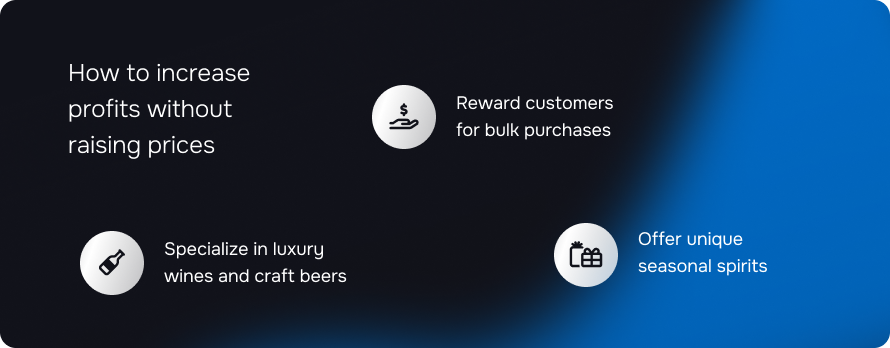
1. Lean into a Niche
Competing with big-box stores to offer the best prices on popular brands can feel like a race to the bottom. Instead, focus on crafting a luxury experience and offering products that customers can’t find anywhere else.
Craft beers from local breweries, rare and aged wines, and premium spirits all have high liquor profit margins, and offering them can help you attract customers looking for quality over bargains.
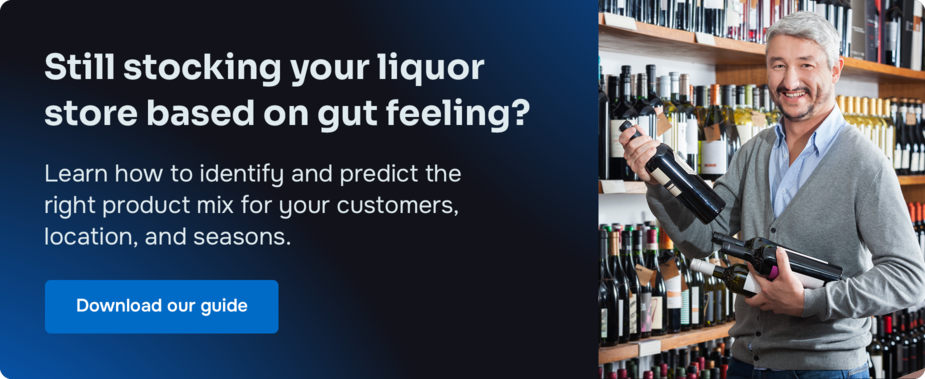
2. Encourage Bulk Purchases
Want to put your customers in a spending mood? Then give them an opportunity to save.
Offering tiered discounts encourages shoppers to buy their favorites in bulk, letting you bring in more revenue per transaction and lowering your marketing costs. For example, you might charge a standard price for a single bottle but offer a slight discount on a full case of liquor.
You can also offer mix and match deals that allow customers to purchase multiple bottles of different brands for a lower overall price.
3. Optimize for Seasonal Shifts
Flexibility and adaptability are key to liquor store profitability, especially during seasonal changes.
Aligning your inventory strategy with seasonal shifts in product demand will help you avoid overstocking, stockouts, and cash flow issues — all of which can dent your store’s bottom line.
Here are our tips to keep the sales flowing year-round:
- Summer: Stock more ready-to-drink cocktails and seltzers.
- Fall: Increase craft beer and premium wine inventory.
- Winter: Focus on gift sets and premium spirits.
- Spring: Highlight rosé wines and spring seasonal beers.
Use these guidelines to help you plan for each season, but rely primarily on your POS system’s sales reports to help you understand how your customers’ wants and needs change throughout the year.
How To Keep Costs Low and Liquor Store Profits High Through Operations
Liquor store profitability isn’t just about stocking the right products and charging the right prices; it’s also about making your operations as smooth as your spirits.
Implementing the right inventory management techniques, training your staff, and providing a top-shelf customer experience are all must-haves for success. Let’s take a closer look at our top tips to optimize your operations.
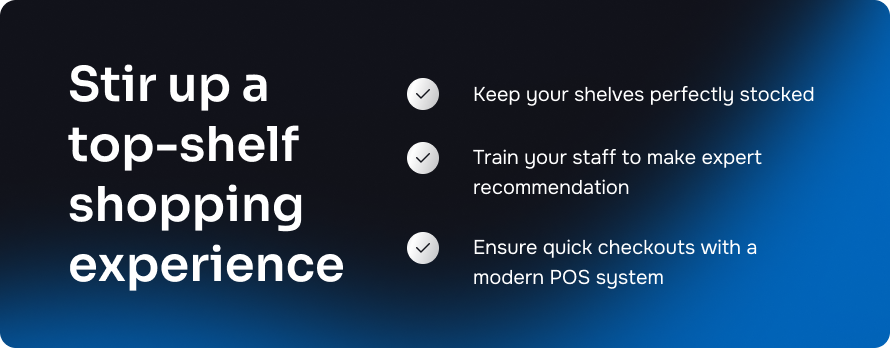
1. Manage Your Liquor Inventory Effectively
Inventory management mistakes can slash your liquor store’s profits, which is why you need to invest in the right tools and techniques to keep your shelves well-stocked.
Most importantly, you need a liquor POS system with powerful liquor inventory tracking features like:
- Real-time inventory tracking: Get an accurate overview of your stock levels at any time, from anywhere. Look for software that breaks down your inventory by the case and individual bottle.
- Product ranking: Discover how each of your liquor store’s products performs, giving you the insights to stock more bestsellers and fewer money pits.
- Automation tools: Protect your time and bottom line with tools like automated purchase order creation and receiving.
- Shrinkage tracking: Understand how theft and breakage affect your sales and stock levels, and take action to secure your inventory.
These features will save you time and ensure your shelves are always stocked with the perfect balance of inventory, keeping your customers happy and your profits healthy.

2. Train Your Staff
Selling a greater volume of luxury liquors, fine wines, and specialty beers can help you achieve an overall higher profit margin, but your customers won’t naturally gravitate toward these products. That’s where your employees come in.
Train your team to make expert product recommendations, understand the flavor and quality differences between top-shelf and bottom-shelf spirits, and guide customers to your high-profit-margin options without being pushy.
Along with promoting your most profitable products, your staff can protect your bottom line by minimizing shrinkage. Train them on spotting and apprehending shoplifters and handling and stocking bottles carefully to prevent breakage.
3. Improve the Customer Experience
Attracting customers by offering the lowest prices in the neighborhood isn’t always the best strategy. Instead, focus on providing an excellent experience that justifies your higher profit margins.
Here are a few ways to provide a top-shelf shopping experience.
- Craft a premium atmosphere: Attractive, well-organized displays, thoughtfully curated music, and soft lighting indicate to customers that shopping in your liquor store is a luxury experience.
- Provide above-and-beyond service: Train your employees to greet customers warmly, offer expert assistance on the sales floor, and ensure a convenient, smooth checkout process by investing in a modern POS system.
- Offer tastings: Give customers peace of mind about their purchases by letting them sample your most popular (and most expensive) wines, beers, and liquors.
- Accommodate special orders and requests: Appeal to collectors and enthusiasts by accepting product requests and placing special orders to ensure they can access rare, exciting products.
- Launch a customer loyalty program: Cultivate a community of luxury liquor enthusiasts through special offers and marketing messages.
Customers who appreciate these special touches are willing to pay a premium for an elevated experience.
Measuring Liquor Store Success and Profitability
Adjusting your prices, managing inventory more effectively, and elevating the customer experience are all great ways to boost your liquor store’s profitability — but by how much?
The answer lies in your POS system’s sales reports. These reports reveal valuable information like:
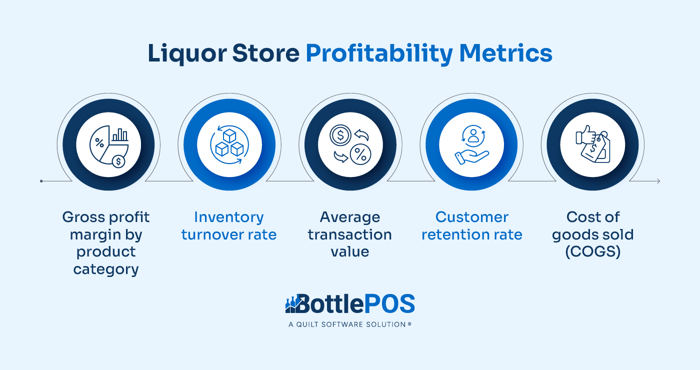
- Gross profit margin by product category: This report will help you understand which types of products are most profitable, helping you make more informed decisions about stocking and promotions.
- Inventory turnover rate: This metric reveals which products are most popular. Understanding your inventory turnover rate can help you understand your customers’ shopping habits and proactively prevent stockouts.
- Average transaction value: This metric reveals how much your customers usually spend during each visit to your liquor store. Increasing your average transaction value is a solid strategy for boosting profits.
- Customer retention rate: This metric reveals how many sales come from repeat customers. Improving customer service and launching a loyalty program are two of the best ways to increase your customer retention rate.
- Cost of goods sold (COGS): This report helps you track inventory costs and more accurately calculate your overall profit margin.
We recommend diving into your POS system’s reporting suite at least once per month to check these metrics and compare them to historical data. If you notice a spike in your overall sales, inventory turnover rate, or customer retention rate, you’ll know that your profit-boosting strategies are working. If you see a dip in performance, it’s time to pivot.
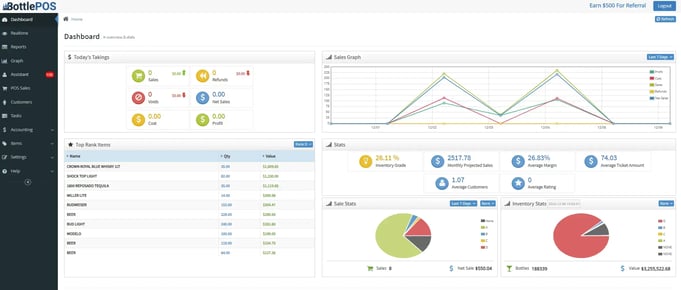
Next Steps To Improve Your Liquor Store Profit Margins
Whether you’re planning a grand opening or have been in business for years, we hope these insights will help you make a plan to boost your liquor store’s profitability.
Before putting your plan into action, let’s make sure you have the right tools for the job. A powerful liquor store POS system like Bottle POS can help you monitor your store’s sales performance, adjust your prices to the right profit margin, and launch promotions like mix and match deals or a customer loyalty program to encourage bulk purchases.
Plus, our POS system is designed to provide your customers with a top-shelf shopping experience, ensuring short checkout lines, well-stocked shelves, and happy customers.
Ready to see how Bottle POS can improve your liquor store’s profit margins? Schedule your personalized demo today to see our software in action.
If you’d like to learn more about running a profitable liquor store, check out these additional resources:
























